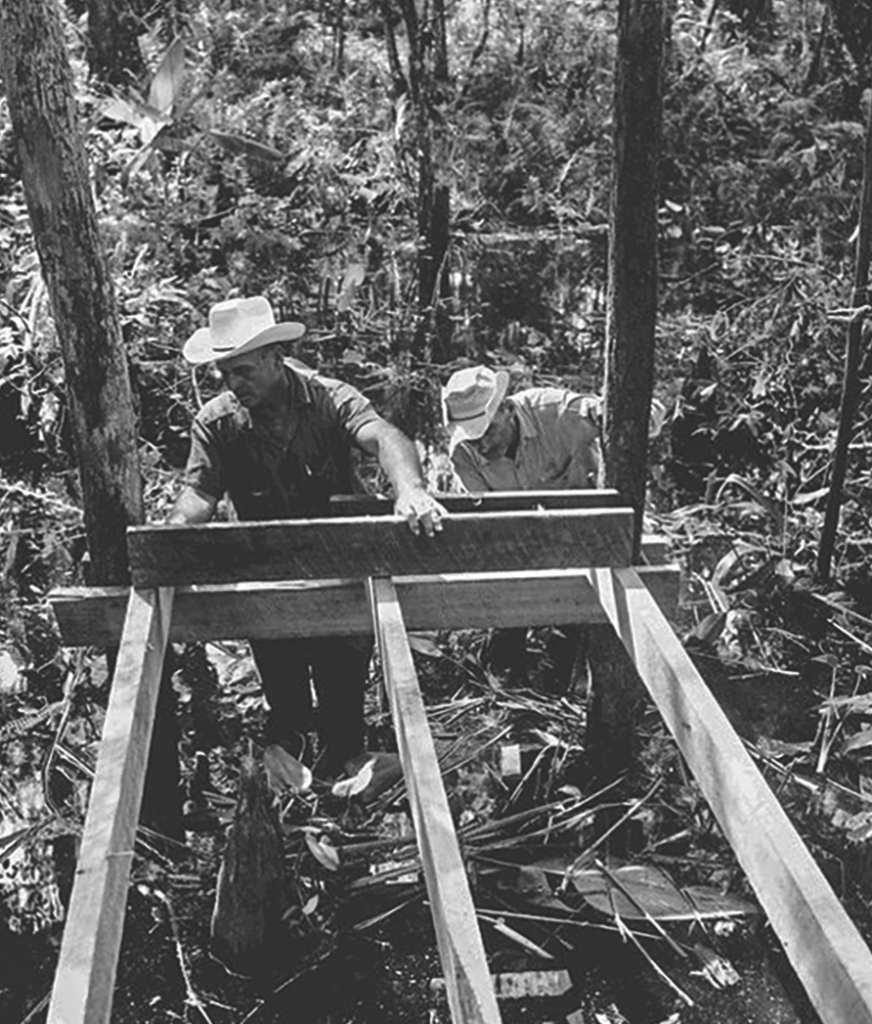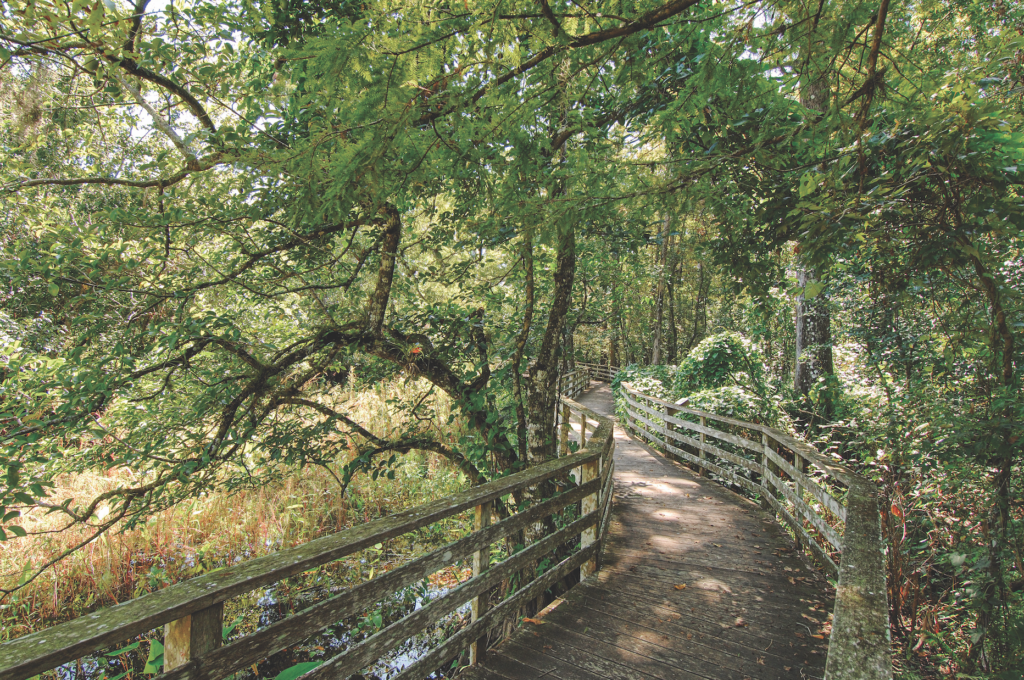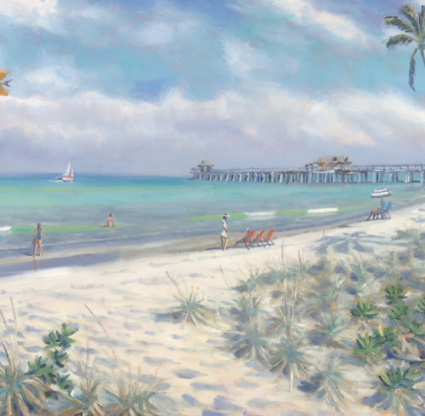On a calm, clear morning, birders, visitors and volunteers stroll the boardwalk at Audubon’s Corkscrew Swamp Sanctuary, stopping to take in views of towering bald cypress trees, patiently waiting for the perfect photo of Florida wildlife or training their binoculars to see which bucket-list bird is perched nearby.
The 13,000-acre, privately owned Naples preserve is home to 17 wading bird species, most famously the formerly endangered wood stork. The birds’ nesting success each year is closely monitored and their population is an indicator of the health of the wetlands. The wood stork features prominently in the story of the sanctuary today, but, more than a century ago, it was a different story starring a very different bird.
In the early 1900s, towering hats festooned with feathers were in fashion. Colonies of birds were hunted for their plumage, including great egrets that nested in the Corkscrew Swamp. “The recognition that the birds needed to be protected is a key point in history,” Sanctuary director Lisa Korte, Ph.D., explains. One of the strengths of the National Audubon Society, she adds, is that it not only focused on wildlife protection, but also helped feather consumers to understand their impact on the bird colonies.

In 1905, the National Audubon Society was founded in an effort to protect all birds, including the colonies of wading birds in Florida that were under threat by the plume industry. In 1912, Corkscrew Swamp got its first official warden in Rhett Green of Fort Myers. The egrets and their plumes were further protected by the 1918 Migratory Bird Treaty Act and saw their numbers rebound. Decades later, a new threat faced the birds and other wildlife that called the swamp home—logging.
By 1954, only one virgin bald cypress stand remained and was the primary nesting site for wood storks. Korte notes that it was the efforts of the Naples community that brought about the preservation of the land.
Corkscrew Swamp Sanctuary was established after 5,680 acres (including a 640-acre gift from Lee-Tidewater Cypress Company) were purchased. John H. Baker, then-president of the National Audubon Society, stated that the new sanctuary was the largest rookery of wood storks and egrets in the country, estimating its size at 8,000 to 10,000 birds.
Construction on the boardwalk began in 1955 under the direction of Hank Bennett, the first sanctuary manager, with local brothers Sam, Bob, Stan and Fletcher Whidden wading in the swamp to complete the work. Water level data collection and wood stork nest monitoring started in 1958. Ed Carlson, sanctuary director emeritus, first visited the sanctuary in 1968 and spent that summer adding the section of the boardwalk that transformed it from a single out-and-back hike to a loop. “I loved that place so much,” Carlson says. “I was like a duck in water, just as happy as I could be.” Carlson worked at the sanctuary during his college years, then became a research biologist on the property until he accepted the position of sanctuary director in 1983, one year before the wood storks were added to the federal endangered species list. “I remember the days when there were thousands of nesting pairs of wood storks in the trees at Corkscrew,” Carlson says.
The industrialization of local agriculture, particularly citrus, caused a major shift in land use, quickly followed by increased residential development. Though their nesting area in the sanctuary was preserved, wood storks were losing feeding grounds at an alarming rate, continuing the population’s decline.


“I see the Sanctuary as a model for best practices for conservation,”
Corkscrew Swamp Santuary’s director, Lisa Korte, says.
The push to preserve the watershed surrounding the sanctuary led Carlson to submit an application to Save Our Rivers, a land acquisition program through the South Florida Water Management District. He applied for a parcel, but the project sat until 1989 when the formation of the Corkscrew Regional Ecosystem Watershed (CREW) Land & Water Trust led to the establishment of a 60,000-acre watershed, of which the sanctuary was a part. Carlson formerly served on the Board of Trustees for the CREW Trust and considers his part in the CREW Project one of the greatest accomplishments of his life.
Another great accomplishment was the sanctuary’s capital campaign that started in 1994, which included the installation of the Living Machine, a wastewater treatment system that uses plants to treat and recycle water; building an environmentally conscious parking lot; replacing the boardwalk; and building the visitor center, which opened in December 2000. “That really opened up the sanctuary to the public in new ways,” Korte says, noting that educating visitors is key to helping them understand their role in the watershed and become decision-makers about wetlands in their own communities.
The wood stork population has made a slow comeback and their status was changed from endangered to threatened in 2014. Data collection on water levels and wood stork nesting success continues at the sanctuary. Land preservation has helped the wood stork population but future restoration is key, including the removal of invasive plants that threaten to alter the hydrology of the land. “I see the sanctuary as a model for best practices for conservation,” Korte says. “As a land owner, we have the ability to conserve our land and be an example for others.”



